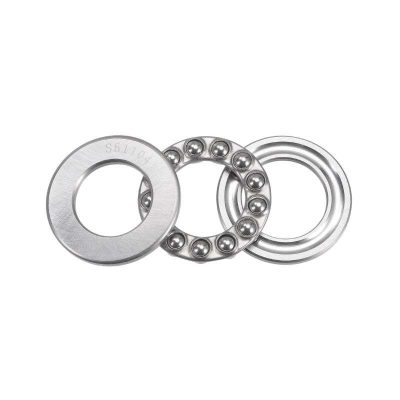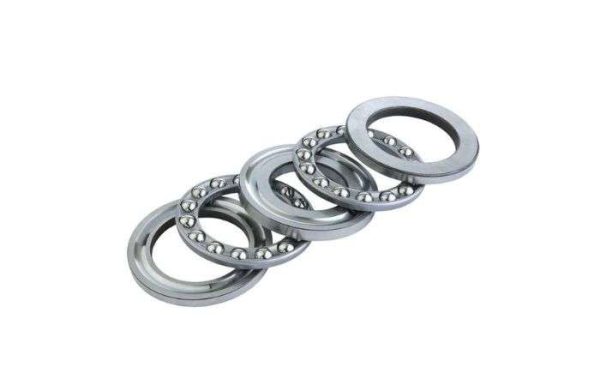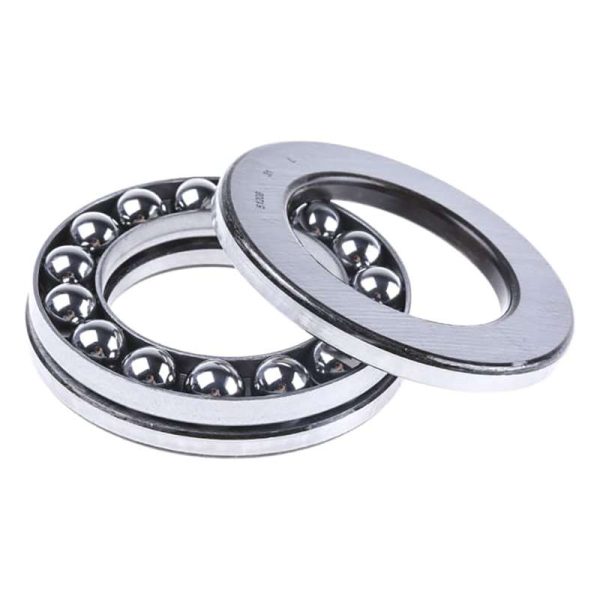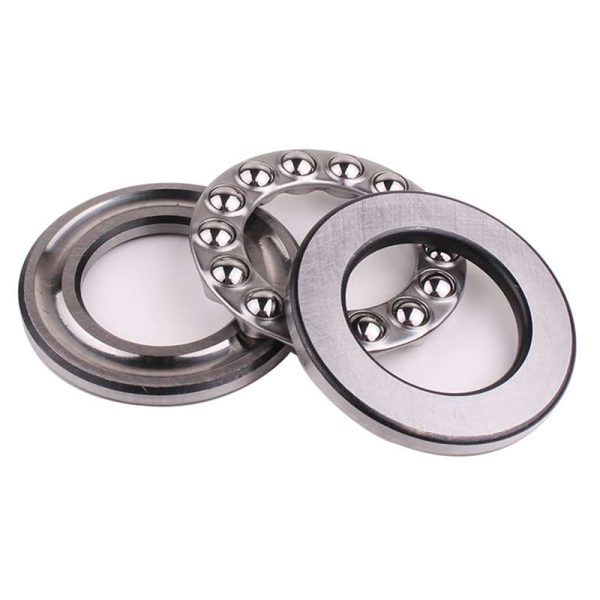Thrust Ball Bearings
Table of Contents
Categories
-
Adapter Sleeves (9)
-
Ball Bearings (11)
-
Ball Screw Bearings (2)
-
Ceramic Bearings (27)
-
Pillow Block Bearings (4)
-
Plain Bearings (32)
-
Roller Bearings (12)
-
Slewing Bearings (43)
-
Sliding Block (3)
-
Stainless Steel Bearings (27)
-
Super Precision Bearings (6)
-
Thin Section Bearings (9)
-
Track Rollers (4)
-
Universal Joints (1)
Definition of Thrust Ball Bearings
Thrust ball bearings are essential components designed to support and withstand axial loads in industrial machinery. They utilize ball bearings to facilitate smooth rotation and precise axial motion, making them crucial for applications where managing axial forces is a primary concern.

FHD Bearings is an ISO 9001:2015 certified manufacturing enterprise .Our company has a wide range of products in stock covering a wide range of areas to ensure that we are able to meet the diverse needs of our customers. We offer a wide selection of both models and specifications to ensure that our customers are able to quickly obtain the products they need and meet their specific engineering and business requirements.
Materials of Thrust Ball Bearings
-It is the most common and widely used bearing material with good strength and wear resistance.
-The main factors in FHD’s choice of steel are its excellent strength and wear resistance to ensure that thrust ball bearings can operate stably under high load conditions and have long-term durability.
-Suitable for applications with high demands on anti-corrosive environments, such as food processing or the chemical industry.
-The main factor in FHD’s choice of stainless steel is its resistance to corrosion, which ensures that thrust ball bearings remain in reliable operation for a long time in harsh environments, such as in the food processing or chemical industries.
-Light weight, high hardness and corrosion resistance are used to improve bearing performance and reduce friction.
-The main factors for FHD to choose ceramic material for thrust ball bearings were the light weight, high hardness and corrosion resistance of ceramics to improve bearing performance and reduce friction.

Alloy Steel
The use of alloy steels may be an option in high temperature or high load conditions to provide better wear resistance and fatigue resistance.
Plastic
In some special applications, such as medical equipment, lightweight plastic materials can be used for thrust ball bearings.
Features of Thrust Ball Bearings

1.High Axial Load Carrying Capacity: Designed to withstand large axial loads, it has excellent load carrying capacity in the axial direction.
2.High Motion Accuracy: Ball design provides excellent motion control for applications requiring precise axial positioning.
3.Simple construction: Typically consists of internal and external rails and ball bearings, making it relatively simple to manufacture and maintain.
4.Available for High Speed Motion: Low coefficient of friction for high speed motion scenarios and reduced energy loss.
5.Various material options: Different materials can be selected, such as steel chrome, stainless steel, ceramic, etc., to meet different industrial environments and specific requirements.
6.Wide range of applications: Widely used in industrial machinery, automotive industry, aerospace and other fields, suitable for a variety of heavy-duty working conditions.
Advantages of Thrust Ball Bearings
- Compact: Compact construction provides strong axial support in limited space for applications with restricted design space.
- Directional: Designed to withstand axial loads, the clear directionality ensures that axial forces are effectively supported and transmitted.
- Ease of Installation: Relatively simple installation allows for quick and easy integration into a variety of mechanical systems.
- Cost-effective: Provides strong performance at relatively low manufacturing costs, making it a cost-effective bearing choice.
- Adjustable: Some designs allow the bearing clearance to be adjusted to suit the needs of different operating conditions, increasing flexibility.
- Low Friction Loss: Low friction loss during motion helps improve efficiency and reduce wasted energy.
- Adaptable to multiple working conditions: Due to their diverse material options and design flexibility, thrust ball bearings are adaptable to different working conditions and environmental requirements.

Applications of Thrust Ball Bearings

- Industrial Machinery: Used to support and bear large axial loads generated in heavy industrial machinery, such as excavators, presses and so on.
- Automobile transmission system: used in the automobile transmission system of the clutch and transmission bearing, support the axial force generated by the engine.
- Wind Turbine Generator: In the main bearing of wind turbine generator, to support the axial load on the impeller.
- Aerospace: Used to support aircraft landing gear, control rudder surfaces and other key components to ensure axial motion control of the vehicle.
- Water pumps: in the axial bearing system of water pumps to support the axial load on the impeller.
- Power industry: In equipment such as generators and turbines, to support the large axial loads generated by the rotor.
- Medical equipment: Used in some medical equipment such as scanners and X-ray machines to provide precise axial motion control.
- Air Conditioning Compressors: In air conditioning systems, to support axial loads on compressors to ensure stable operation.
- Marine Equipment: Provides support for axial forces in ship’s lift mechanisms and propulsion systems.
- Power Tools: Main bearings used in power tools to support high speed rotation and provide stable axial motion.
Key Manufacturing Process of Thrust Ball Bearings
Material selection: Select appropriate materials, such as steel chromium, stainless steel, ceramics, etc., according to the use of the environment and performance requirements of the bearing.
Cold working process: carry out cold working process, such as cold drawing or cold rolling, in order to improve the mechanical properties of the material, improve the hardness and strength.
Heat treatment: heat treatment process, such as quenching, adjust the crystal structure, increase the hardness and wear resistance of bearings.
Assembly: The assembly of bearing components, such as inner and outer rings and balls, usually requires precision centering and clearance adjustment.
Lubrication: The addition of appropriate grease or oil to minimize friction, cool and prevent rusting of bearings.
Quality inspection: Various quality inspections are performed, including visual inspections, dimensional measurements, bearing motion tests, etc., to ensure that the product meets design and performance standards.
Packaging: Packaging the finished products to ensure that they are not damaged during transportation and storage, and provide clear identification and instructions.

FAQ - Frequently Asked Questions

Thrust ball bearings focus on handling axial loads and differ significantly from radial bearings (e.g. deep groove ball bearings) in design and application.
Thrust ball bearings in automotive driveline systems can effectively support axial loads generated by engines and driveline systems, improving performance and reliability.
The maximum load carrying capacity depends on the size and material of the bearing, which is usually capable of handling large axial loads.
Stainless steel thrust ball bearings are suitable for environments with high anti-corrosive requirements, such as food processing and medical equipment.
The life cycle depends on the conditions of use and maintenance. Correct use and regular maintenance can extend the life of the bearings.
In wind turbines, thrust ball bearings support the axial load on the impeller to ensure the stable operation of the wind turbine.
Axial ball bearings specialize in axial loads, while angular contact ball bearings can handle both axial and radial loads.
Keep the bearings centered when mounting, choose proper grease or oil when lubricating, and make sure the lubrication channel is free.
Advantages include strong axial load carrying capacity, high-precision motion control, simple structure, and adaptation to high-speed motion.
Common applications include industrial machinery, the automotive industry, aerospace, the energy industry and marine engineering.
Installation and Maintenance
Installation
- Environment Preparation: Perform the mounting in a clean, dust-free environment, making sure the work area is clean and avoiding dust and foreign matter from entering the bearings.
- Bearing Inspection: Check the appearance of the thrust ball bearings to ensure that there is no obvious damage or defects, and verify that the bearings meet the specifications.
- Shaft and Seat Preparation: Clean the surfaces of the mounting shaft and seat to ensure that they are smooth and free of scratches, and apply appropriate lubricant if required.
- Alignment Adjustment: Ensure that the bearing is properly centered to avoid uneven loading, which can be adjusted with specialized tools.
- Bearing Installation: Slide the bearing gently into the seating ring, avoid collision and damage, make sure the bearing is in the right position.
- Fixing bearings: According to the design of the equipment, use appropriate fixing methods (e.g. bearing caps, screws) to ensure that the bearings are firmly installed.
- Lubrication: According to the manufacturer’s recommendations, add the appropriate amount of grease or lubricant to ensure that the bearings are adequately lubricated during operation.
- Cover assembly: Install the cover to ensure dustproof and waterproof, and improve the service life of the bearings.


Maintenance
- Regular Lubrication: Regular lubrication at the manufacturer’s recommended lubrication intervals ensures that the bearings are properly lubricated during operation.
- Monitor Temperature: Regularly monitor the temperature of the bearings. Abnormal warming may be a sign of inadequate lubrication or other problems.
- Clean the environment: Clean the bearings and their surroundings regularly to prevent dust and dirt from accumulating and affecting bearing performance.
- Vibration monitoring: Use vibration monitoring equipment to regularly check the vibration level of the bearing and whether there is any abnormal vibration.
- Check seals: Regularly check bearing seals to ensure they are in good condition and to prevent lubricant leakage and contamination.
- Replacement cycle: Regularly inspect the bearings and replace them as necessary based on usage and manufacturer’s recommended life.
- Avoid overloading: Avoid overloading and ensure that the bearings operate within the specified load range.
- Train maintenance personnel: Train maintenance personnel on the characteristics of thrust ball bearings and proper maintenance procedures.
Related Posts
Comprehensive Guide: What Brand Procurement Professionals Must Know About Thrust Ball Bearings Selection, Application And Maintenance
Table of Contents Categories Comprehensive Guide: What Brand Procurement Professionals...
Read MoreThrust Ball Bearings In Machinery And Equipment Applications
Table of Contents Categories Thrust Ball Bearings In Machinery And...
Read MoreSalt Bath Heat Treatment Process: Precision Forging Of Metallic Materials
Table of Contents Categories Salt Bath Heat Treatment Process: Precision...
Read MoreThe Versatility And Impact Of Ball Bearings
Categories The Versatility And Impact Of Ball Bearings Table of...
Read MoreIn-Depth Comparison: Wheel vs Hub Bearings
In-Depth Comparison: Wheel vs Hub Bearings Table of Contents Introduction...
Read MorePrecision Engineering with Angular Bearings
Precision Engineering with Angular Bearings Table of Contents The Crucial...
Read MoreUnlocking Efficiency: Self Aligning Ball Tech
Discover the transformative power of self-aligning ball bearings. From their...
Read More




















